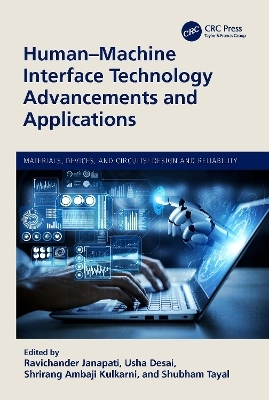
Human-Machine Interface Technology Advancements and Applications
CRC Press (Verlag)
978-1-032-35152-0 (ISBN)
Human–Machine Interface Technology Advancements and Applications focuses on analysis, design, and evaluation perspectives in HMI technological breakthroughs and applications. It covers a wide range of ideas, methodologies, approaches, and instruments to give the reader a thorough understanding of the field's current academic and industry practice and debate. Physical, cognitive, social, and emotional factors are all considered in the work, which is exemplified by key application fields such as aerospace, automobile, medicine, and defense. This book covers AI and machine learning methodologies as well as biological signals and HMI applications. Nanotechnology, user interface design, and interactive systems are also featured. The MATLAB approach to signal processing applications is also included.
This book discusses advances in the field of human–machine interfaces and provides practical knowledge in biomedical signal processing, AI, and machine learning. It discusses augmented reality/virtual reality-based HMI applications. It examines advances in nanotechnology, user interface design, and interactive systems.
This book is intended to serve as a research guide that will both inform readers about the fundamentals of HMI from academic and industrial perspectives and provide a glimpse into how human-centered designers, such as engineers and human factors specialists, will attempt to design and develop human–machine systems in the future.
Dr. Ravichander Janapati is Associate Professor at Department of ECE, SR University, Warangal. He is a senior member of IEEE. He graduated in Electronics and Communication Engineering from JNTU Hyderabad and received his PhD in the Adhoc Wireless Sensor Networks field and M. Tech in Digital Electronics and Communication Systems from the Jawaharlal Nehru Technical University, Anantapur. His areas of interest are wireless sensor networks and brain–computer interface. Dr. Usha Desai is Professor and Head at Department of ECE, SR University, Warangal. She received her PhD in the area of Biomedical Signal Processing from REVA University, Bengaluru in 2017 and M. Tech in Digital Electronics from Visvesvaraya Technological University, Belagavi, Karnataka. Dr. Shrirang A. Kulkarni is Post-Doctoral Fellow with the School of Global Health Management and Informatics, University of Central Florida. Before joining UCF, he worked as an Associate Professor with the Department of Computer Science and Engineering at National Institute of Engineering, Mysore, India. He earned his PhD in Computer and Information Science from Visvesvaraya Technological University in the year 2012. His current research work includes developing new algorithms for analysis of healthcare data using machine learning. He is also a senior member of Association for Computing Machinery (ACM). Dr. Shubham Tayal is Assistant Professor in the Department of Electronics and Communication Engineering at SR University, Warangal, India. He has more than 6 years of academic/research experience teaching at UG and PG levels. He received his PhD in Microelectronics and VLSI Design from National Institute of Technology, Kurukshetra, M. Tech (VLSI Design) from YMCA University of Science and Technology, Faridabad, and B. Tech (Electronics and Communication Engineering) from MDU, Rohtak. He is the editor/coeditor of eight books in total from CRC Press (Taylor & Francis Group, USA) and Springer Nature. He is a recipient of Green ThinkerZ International Distinguished Young Researcher Award 2020. His research interests include simulation and modeling of multigate semiconductor devices, device-circuit co-design in digital/analog domain, machine learning, and IoT.
1. Neural Networks for Human-Machine Interface. 2. An Overview of Recent Approaches in Brain-Computer Interface Systems using Electroencephalography. 3. Automatic Detection of Motor Imagery Eeg Signals Using Swarm Decomposition For Robust BCI System. 4. Analysis of Mental Stress during Public Speaking using Feature Optimization Techniques on EEG Signals. 5. Classification of human emotions based on Electroencephalogram (EEG) using two-layer Gated Recurrent Units (GRUs). 6. Epileptic Seizure Classification Using Machine Learning Algorithms with The Techniques of PCA Feature Reduction. 7. Nano technology advancements in HMI. 8. An Engineering Approach of Non-Invasive Detection and Analysis of Human Heart Sound for Alarm Generation. 9. Image Denoising: An Overview of Important Methods in Spatial and Transform Domain. 10. Diabetic Retinopathy Diagnosis System Based on Artificial Intelligence. 11. Usability to User Experience with Interactive Systems in Biomedical Applications and Devices. 12. Dynamic Energy Management of Hybrid Electric Vehicles (HEVs) using Fuzzy Logic Controller. 13. Predictive Maintenance and Anomaly Detection in Smart Manufacturing. 14. Impact of digitalization and artificial intelligence (AI) on diagnostic pathology: Are we looking at a renaissance? 15. University Chatbot System Using Natural Language Processing.
| Erscheinungsdatum | 26.09.2023 |
|---|---|
| Reihe/Serie | Materials, Devices, and Circuits |
| Zusatzinfo | 29 Tables, black and white; 90 Line drawings, black and white; 26 Halftones, black and white; 87 Illustrations, color; 29 Illustrations, black and white |
| Verlagsort | London |
| Sprache | englisch |
| Maße | 156 x 234 mm |
| Gewicht | 600 g |
| Themenwelt | Schulbuch / Wörterbuch |
| Informatik ► Software Entwicklung ► User Interfaces (HCI) | |
| Naturwissenschaften ► Biologie | |
| Technik ► Umwelttechnik / Biotechnologie | |
| ISBN-10 | 1-032-35152-7 / 1032351527 |
| ISBN-13 | 978-1-032-35152-0 / 9781032351520 |
| Zustand | Neuware |
| Informationen gemäß Produktsicherheitsverordnung (GPSR) | |
| Haben Sie eine Frage zum Produkt? |
aus dem Bereich


